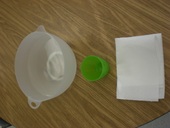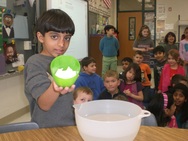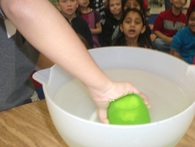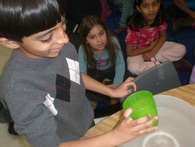The children were very excited to take part in a scientific experiment this week. This was a preview of concepts we will discuss in more detail later in the year during our unit on states of matter. This project will be on display during Mill Run's Science Expo February 6th. Here are the steps of our project:
Question: Can two types of matter be in the same place at the same time?
Hypothesis: We considered the materials needed and the procedure. We each made a prediction of what we thought would happen.
Question: Can two types of matter be in the same place at the same time?
Hypothesis: We considered the materials needed and the procedure. We each made a prediction of what we thought would happen.

Materials: a bowl of water, a cup, and a paper towel
Procedure:
First, fill a bowl with water.

Then, crumple a small paper towel and stuff it in the bottom of a cup.

Next, turn the cup upside down and put it in the bowl. Hold it firmly. Count to ten.

After that, take the cup out of the bowl.
Finally, look inside the cup.
Results: We discovered that the paper towel was still dry inside the cup. We noticed that when we placed the cup in the bowl, it made a smacking sound when it touched the water. Also, it took strength to hold the cup in position in the bowl.
Conclusion: We decided that two types of matter cannot be in the same place at the same time. Air was trapped inside the cup, and the air kept the paper towel from getting wet.
Finally, look inside the cup.
Results: We discovered that the paper towel was still dry inside the cup. We noticed that when we placed the cup in the bowl, it made a smacking sound when it touched the water. Also, it took strength to hold the cup in position in the bowl.
Conclusion: We decided that two types of matter cannot be in the same place at the same time. Air was trapped inside the cup, and the air kept the paper towel from getting wet.
As we begin the third quarter, we are beginning some new units of study.
In math, we are beginning a quick unit focusing on place value. We have been touching on place value all year during our calendar time within our morning meeting. Key concepts in this unit include:
We will also continue using Reflex Math and the Math Masters program (aka Rocket Math) to measure our progress in recalling basic addition facts quickly and accurately.
In reading and writing, we will use question words to enhance our understanding and our work. In reading, we will ask and answer wondering questions to monitor our understanding of the text. For example, Where is the story taking place? Who is important? What has happened so far? Why did the character do that? How did they get here? Providing the answers to questions like these can improve our written work as well.
In social science, we are learning about famous Americans and their contributions to society. Specifically, we will focus on Benjamin Franklin, George Washington, Abraham Lincoln, George Washington Carver, and Eleanor Roosevelt. We have also learned about Martin Luther King, Jr. and Rosa Parks. Our "I can make a difference" essays, inspired by the work of Martin Luther King, Jr. are on display in the hallway.
Question: If you were in charge of first grade curriculum for the Virginia Department of Education, what famous Americans would you add to our list?
In math, we are beginning a quick unit focusing on place value. We have been touching on place value all year during our calendar time within our morning meeting. Key concepts in this unit include:
- understanding the expanded form of a two-digit number (74 = 7 tens and 4 ones),
- representing a two-digit number with a visual diagram of tens and ones, and
- solving to find the number when you add or subtract one, or when you add or subtract one ten (74 + 1 = 75, 74 + 1 ten = 84).
We will also continue using Reflex Math and the Math Masters program (aka Rocket Math) to measure our progress in recalling basic addition facts quickly and accurately.
In reading and writing, we will use question words to enhance our understanding and our work. In reading, we will ask and answer wondering questions to monitor our understanding of the text. For example, Where is the story taking place? Who is important? What has happened so far? Why did the character do that? How did they get here? Providing the answers to questions like these can improve our written work as well.
In social science, we are learning about famous Americans and their contributions to society. Specifically, we will focus on Benjamin Franklin, George Washington, Abraham Lincoln, George Washington Carver, and Eleanor Roosevelt. We have also learned about Martin Luther King, Jr. and Rosa Parks. Our "I can make a difference" essays, inspired by the work of Martin Luther King, Jr. are on display in the hallway.
Question: If you were in charge of first grade curriculum for the Virginia Department of Education, what famous Americans would you add to our list?
 RSS Feed
RSS Feed